It hasn’t always been sunshine and roses for Deadpool. He might be the star of his own videogame and appear in multiple comics each month, but there was a time when his series was regularly being considered for cancellation, supported only by a small yet devoted cult following.
How did he rise in popularity? When did he start breaking the fourth wall? And where should you begin if you want to read the comics? Read on for the answers to these pressing questions, and more.
The Early Years
Deadpool began life as a character design in the sketchbook of Rob Liefeld while he was illustrating and writing plots for Marvel’s New Mutants, which transformed soon after into X-Force. Liefeld has had a long history of creating characters that are thinly-veiled reproductions of existing characters, and Deadpool was one of his first. Fabian Nicieza, who wrote dialogue for New Mutants and X-Force during Liefeld’s run, immediately noticed the character’s resemblance to Deathstroke The Terminator from New Teen Titans. As an in-joke, Nicieza decided to name him Wade Wilson, in reference to Deathstroke’s secret identity Slade Wilson.
Deadpool’s personality developed slowly sporadic appearances in X-Force as a recurring villain, but became much more fleshed out as a character in his first mini-series. Deadpool: The Circle Chase was written by Nicieza and illustrated by a then-unknown Joe Madureira, who went on to become creative director on Darksiders and its sequel. It introduced us to Weasel, Deadpool’s sidekick who supplies him with various weapons and gadgets, and for the first time shows Deadpool saving a life rather than taking one.
Deadpool: Sins Of The Past followed a year later, in which writer Mark Waid and artist Ian Churchill finally revealed what Deadpool looked like under the mask. Unfortunately, the mini-series can be a little difficult to read, due to chaotic panel layouts being in fashion at the time. Interestingly, Nicieza had pitched his own sequel to Deadpool: The Circle Chase, but was turned down due to it being considered “too dark.”
Joe Kelly’s Run
The X-Men were created by Stan Lee and Jack Kirby in 1963, but any comics historian will tell you that no writer had a larger impact on the characters than Chris Claremont. Likewise, while Rob Liefeld and Fabian Nicieza are credited with creating Deadpool, it was Joe Kelly who reinvented him into a popular character.
Joe Kelly and artist Ed McGuinness were relative unknowns when they were assigned to launch a Deadpool ongoing series in 1997. Under Kelly, the humor became funnier and the darkness became bleaker, while the cartoony style of McGuinness’ art complimented the violence of the series in a way you might not have predicted.
The series introduced us to Deadpool’s living situation. It turns out he’d been keeping an old blind woman he called Blind Al as a prisoner in his home for years. However, the way they’d trade insults and prank each other hinted that the relationship might be more complicated than it seemed. At times she almost appeared to be more of a housesitter than a prisoner, as the doors were never locked. Yet Deadpool kept her existence a secret even from his pal Weasel.
Kelly continued the plot thread from the mini-series of a killer trying to save people, and pushed it to the extreme. Kelly took a character who is essentially a sociopath, and threw him into a situation where he’s inspired to become a hero; attempting to navigate the path of good without the benefit of a moral compass.
As a result, we began to sympathize with him…and Kelly used this to his advantage, in order to send us on an emotional rollercoaster ride. He’d use humor to lull you into a false sense of security, so he could pull the rug out from under you with a serious moment when you least expect it. Kelly would regularly remind us what a despicable person Deadpool has been, yet we’d continue to root for the character, because we could see how hard he was trying to figure out this whole hero thing and wanted him to succeed.
We wanted to believe Blind Al wasn’t really a prisoner, because we wanted Deadpool to be good. When it was finally made clear to just what extent Al was still a prisoner, it was horrifying. Yet when Deadpool considered letting her go — or rather, forcibly removing her from the house because she didn’t want to leave — we felt torn that he might be losing a positive influence in his life…
Joe Kelly’s run wasn’t just a parade of zany insanity. It messed with your head.
The series developed a small but dedicated following of internet-savvy fans. When word got out that the series was going to be cancelled, in the early days of online comics news, fans rallied around the book…and succeeded. Though it turned out to only be a temporary stay of execution. The book went on the chopping block again…and fans rescued it again.
At the beginning, being always on the cusp of cancellation meant Joe Kelly could do whatever he wanted with the character and receive no interference. However, once the status quo of perpetual cancellation and un-cancellation set in, it began to have a negative impact on the pacing of the stories. Every time Kelly was told it was cancelled, he’d start wrapping up all the remaining plot threads, only to be informed it was un-cancelled.
Eventually he decided to just wrap it up for real and move on, and ended his run with issue #33. Although he’d been convinced the book was going to be cancelled soon anyways, it continued on for several more years without him. Since then, he’s gone on to write X-Men, Action Comics, JLA, and Spider-Man, co-write the videogame X-Men: Legends, and co-create Ben 10.
Unfortunately, Ed McGuinness only stayed up to issue #10 (incidentally, leaving to work on a series published by Rob Liefeld). The strength of his visual storytelling was immediately missed, with later stories bogged down by a string of subpar artists. Kelly’s writing remained just as sharp, but it can require some patience to plod through frequently confusing storytelling and less-than-inspired art.
Breaking The Fourth Wall
Joe Kelly’s run introduced Deadpool to breaking the fourth wall, but it didn’t happen immediately; it was a very gradual progression.
On the very first page of Deadpool #1, he poked fun at comic narration in a manner resembling The Tick. However, note that he’s not actually breaking the fourth wall and addressing the audience. He’s simply talking to amuse himself.
Incidentally, Joe Kelly’s run also popularized recap pages in modern comics. His page one recaps were so popular that Marvel started placing recaps in the inside cover of every book for several years. Page one of Deadpool #4 features several character breaking the fourth wall to deliver a recap.
In Deadpool #11, Blind Al and Deadpool get stuck in the past. In a unique twist, Joe Kelly decided to have them drawn into an actual issue of Amazing Spider-Man from the ’60s. This opened up opportunities for Deadpool to poke fun at the art, though it wasn’t just him — Blind Al also got in on the act.
The first time Deadpool actually addressed the audience was a short story in Deadpool #0, a promotional giveaway from Wizard Magazine. However, the story doesn’t take place in continuity (as is made very clear by the ending).
It was over a year later that Deadpool first addressed the audience in the main series, in Deadpool #27, the infamous “Shoryuken” issue. Because he was suffering from hallucinations at the time — which was not a normal occurrence for him — the fourth wall break didn’t seem that unusual.
However, after he was cured of his hallucinations, it was hilariously unexpected for him to break the fourth wall in normal conversation. That Bullseye didn’t react at all somehow made it even funnier.
In Joe Kelly’s series ending for issue #33, he intended for Deadpool to die and go off to “live” happily ever after with Death. However, he was informed that the series wasn’t cancelled after all, and quickly rewrote the last two pages to say that Deadpool was only temporarily dead. “The big wigs in the sky took a vote and decided you have to go back…you’re not done suffering yet.” You could say his experiences with Death were the turning point where he managed to discover he was a character in a book.
Christopher J. Priest took over the book with issue #34. He was handed the book in part because he was known for being good at injecting humor into his stories. He’d written a book for Acclaim’s comic division called Quantum And Woody, which gained a similar cult following to Deadpool. He also occasionally inserted pages like this into his run on Marvel’s Black Panther:
He was also known for being the writer that editors tended to hand poor selling books to before cancelling them. Since Joe Kelly had already mentioned “The Land Of Cancelled Heroes” on his final page of Deadpool, Priest decided to start from there and poke fun at his reputation. After throwing out a bag labeled “every good idea Kelly ever had and everything that made this book work,” Deadpool enters a room filled with every cancelled character Priest has ever touched. He then turns around, and tries to get as far away as he can.
When he wakes up, he finds himself in a lab, where he has the following conversation:
“And you truly believe that?,” the scientist asks.
Deadpool reponds, “Mister, if I didn’t, I woulda ate my gun years ago.”
Joe Kelly may have introduced Deadpool to breaking the fourth wall, but Christopher J. Priest could be credited for establishing it as an essential part of the character’s personality and worldview.
Yet despite his significant contribution to Deadpool, Priest felt he just wasn’t the right guy for the job. You can read his regrets here. Like the last half of Kelly’s run, he was saddled with subpar artists — except for the Jim Calafiore illustrated issues, which were golden — and struggled with the same variety of New 52-style editorial interference that Kelly was simultaneously encountering on X-Men. It certainly didn’t help that he felt he never quite understood the character.
Priest left the series after only one year at issue #45. For a time, writers who followed generally ignored the fourth wall entirely, until Gail Simone took over with issue #65. Having gotten her start in comics writing a satirical column for ComicBookResources.com, Simone’s sense of humor was considered perfect for the title. Her version of Deadpool was known to make frequent use of “little yellow boxes” in order to narrate to and sometimes address the reader.
Simone was paired up with the art studio UDON, who have since become well known for their work with Capcom, and couldn’t have been a better fit for her stories. It seemed like everything was finally starting to go perfectly for our Merc With A Mouth….and then, just as soon as this dream team’s run began, the editors decided to cancel and retool.
Cable was going to be relaunched as Soldier X, in order to play up the book’s connection the X-Men. Likewise, was decided that Deadpool would now be called Agent X, and star a Deadpool-like character who would be more “X-treme,” with a look inspired by The Matrix. Simone and UDON stayed on and tried to make it work, but creative differences with the editors eventually led Simone to leave.
After a five year battle with cancellation, Deadpool‘s time was finally up, fittingly ending with issue #69. A year later, an online imageboard would materialize by the name of 4chan.
Reunions
Unsurprisingly, sales on Agent X weren’t looking good, and the book was set to be cancelled at issue #12. Cable’s series was also being cancelled. Rather than just relaunch both of their books, it was decided that they’d now share one, in a super-powered take on The Odd Couple.
To bridge the gap, Agent X was extended to issue #15, and Gail Simone was asked to return in order to wrap thing up, and bring back Deadpool. This allowed for a fresh start for Cable & Deadpool #1, which saw Deadpool co-creator Fabian Nicieza return to writing the character. Rob Liefeld supplied covers to the first four issues.
Nicieza’s run on Cable & Deadpool last 50 issues, the longest run by any writer with the character up to that point. In fact, the main reason it ended at all likely had to do with Cable being pulled away for major X-Men crossover event, which essentially turned the series into a Deadpool solo title at the end.
During this time, Joe Kelly also had a few brief reunions with the character. In 1996, he and Ed McGuinness teamed up again for Superman/Batman Annual #1, in which a group of DC characters encountered alternate universe versions of themselves. This included Deathstroke, whose double has a comedic tendency to run his mouth off.
Three years later, Joe Kelly contributed a story to Deadpool #900, this time teaming up with Rob Liefeld. Reviewer Paul O’Brien put it best when he described the story as “like having sugar injected into your eyes.” But in the best way possible!
Then, while writing the series Amazing Spider-Man in 2010, Kelly finally wrote the long-awaited meeting of Spider-Man and Deadpool.
Invading Videogames
Deadpool’s first videogame appearance in X-Men Legends II: Rise Of Apocalypse. He’s unlocked as a playable character by defeating him in a boss battle, but you could also unlock him early with a cheat code. Normally if you unlock a character early and have a character fight themselves, you get the the same standard pre-battle dialogue that you would otherwise…but not with Deadpool. In a surprise easter egg, battling him while he’s in your squad results in his having a conversation with himself!
The characters’ cult following led to his return in X-Men Legends sequels Marvel: Ultimate Alliance and Marvel Ultimate Alliance 2, voiced by John Kassir. He then appeared Spider-Man: Shattered Dimensions and Marvel Vs. Capcom 3: Fate Of Two Worlds, voiced by Nolan North.
North returned this year for Deadpool, the character’s first game in a starring role. Unfortunately, reaction from both fans and critics has been fairly mixed, and seem to differ based on how people feel about Daniel Way’s writing.
Daniel Way’s Run
After Cable & Deadpool ended, his series was relaunched with Deadpool #1 by Daniel Way and Paco Medina. Way’s run has been controversial with fans, due to the way he ignored what came before and dramatically changed Deadpool’s personality.
Without explanation, Deadpool was suddenly a schizophrenic with multiple personalities, because apparently all Way knew about the character was that he was crazy and that’s what crazy people do, I guess? Occasional glimpses through Deadpool’s eyes — referred to as “Pool-O-Vision” — revealed to us that Deadpool acts the way he does because he’s a schizophrenic with a warped view of the world, counter to everything we previously knew about the character.
Deadpool had experienced hallucinations before, but there was always an explanation for them. When Deadpool started to hallucinate during Joe Kelly’s run, he seemed extremely alarmed, because this was not normal. In fact, they’re what led to the often reposted “Shoryuken” moment.
Unaware that his hallucinations may have been the fault of his nemesis T-Ray, Deadpool tries seeing a psych to make them go away. The hallucinations seem to be trying to tell him something, but Deadpool and his psych are unsure what. During a therapy session, he realizes that he does his best thinking while focused on a fight, and maybe that’s what he needs right now. So he seeks out Wolverine, because he knows their healing factors will make the fight last a good long time.
Unfortunately, Wolverine is in no mood to fight. He just wants to hang out with his pal Kitty Pryde — who has a similar relationship with Wolverine as Rogue does in the movies — and no goading can change his mind. So out of desperation, Deadpool Shoryukens Kitty Pryde, because he knows that will piss Wolverine off.
Compare this to Daniel Way’s Deadpool, who fights Wolverine because in his warped mind, Wolverine looks like a frightened Looney Tunes character.
Deadpool used to find hallucinations alarming — why doesn’t this Deadpool react at all? For that matter, why isn’t he react to the sudden existence of voices in his head? I can only chalk it up to bad writing from someone who just doesn’t understand the character.
Unfortunately, High Moon Studios got Daniel Way to write the Deadpool game, when almost anyone else would’ve been better. Now most casual fans will forever think of Deadpool as “that crazy guy with the multiple personalities,” because Way was unable to tell the difference between a sociopath and a schizophrenic with dissociative identity disorder.
Where To Start Reading
So you want to read Deadpool’s comics, but you’re not sure where to start. I know it can be a little overwhelming; in the last few years in particular, Marvel has noticed how popular the character is online and decided to flood the market with a glut of spin-offs and mini-series. I’ll try to help narrow things down for you.
[divider]
– Are you most interested in his current stories?
 If you just want to see what the character is up to now, you’ll have no problem jumping right in with Deadpool (2012) #1.
If you just want to see what the character is up to now, you’ll have no problem jumping right in with Deadpool (2012) #1.
The series was recently relaunched with the new creative team of Brian Posehn and Gerry Duggan, and the stories so far are playful and fun, and not overly complex.
You can get Vol. 1 and Vol. 2 in book form, or single issues on Comixology (as they’re released) or Marvel Unlimited (with a six month delay).
If you enjoy that and want more, check out the suggestions below.
[divider]
– Do you want help navigating the best of the old stuff?
I can help you there:
Joe Kelly’s Run (Deadpool #1-33)
The proper order to read Joe Kelly’s run in can be a little confusing due to some complicated numbering conventions. You want to read them like this:
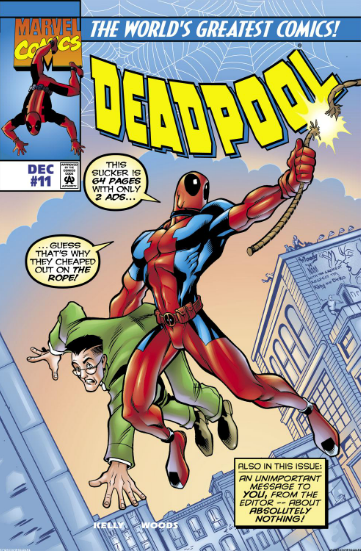 – Deadpool (1997) #1-6
– Deadpool (1997) #1-6
– Deadpool (1997) #-1 (“minus one”)
– Deadpool (1997) #7
– Deadpool/Daredevil Annual ’97
– Deadpool (1997) #8-17
– Deadpool/Death Annual ’98
– Deadpool (1997) #18-33
You can find all of the single issues on Comixology, and most of them on Marvel Unlimited (they’re currently missing #-1, #26, and #28). You can also get the complete run in book form:
Deadpool Classic (Vol. 1)
Contains Deadpool (1997) #1.
Deadpool Classic (Vol. 2)
Collects Deadpool (1997) #2-8, plus Deadpool #-1 and Deadpool/Daredevil ’97.
Deadpool Classic (Vol. 3)
Collects Deadpool (1997) #9-17.
Deadpool Classic (Vol. 4)
Collects Deadpool (1997) #18-25, plus Deadpool #0 and Deadpool/Death ’98.
Deadpool Classic (Vol. 5)
Collects Deadpool (1997) #26-33, plus Baby’s First Deadpool Book
Christopher J. Priest’s Run (Deadpool #34-45)
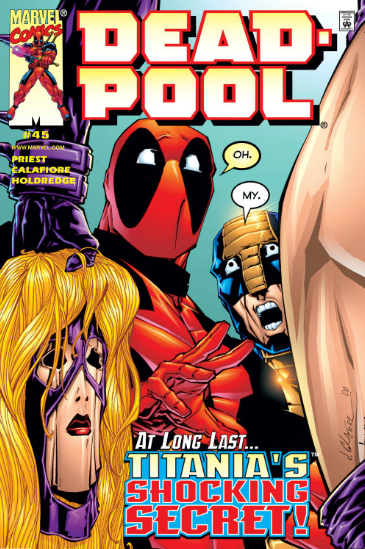 Priest’s entire run can be found on Comixology, and most of it can be found on Marvel Unlimited (they’re currently missing #35). You can also get the complete run in book form:
Priest’s entire run can be found on Comixology, and most of it can be found on Marvel Unlimited (they’re currently missing #35). You can also get the complete run in book form:
Deadpool Classic (Vol. 6)
Collects Deadpool (1997) #34-45, plus Black Panther (1998) #23.
I also recommend looking into his runs on Quantum And Woody (1997) and Black Panther (1998).
[clear] Gail Simone’s Run (Deadpool #65-69, Agent X #1-7, 13-15)
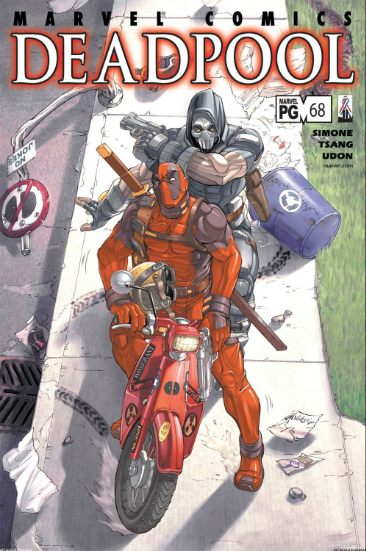 Simone’s run isn’t currently on Comixology, but the entire run can found on Marvel Unlimited. The complete run is soon coming out in book form:
Simone’s run isn’t currently on Comixology, but the entire run can found on Marvel Unlimited. The complete run is soon coming out in book form:
Deadpool Classic (Vol. 9)
Collects Deadpool (1997) #65-69, plus Agent X #1-6.
I also recommend looking into her run on Secret Six (2006) and Secret Six (2008).
[clear] Fabian Nicieza’s Run (Cable & Deadpool #1-50)
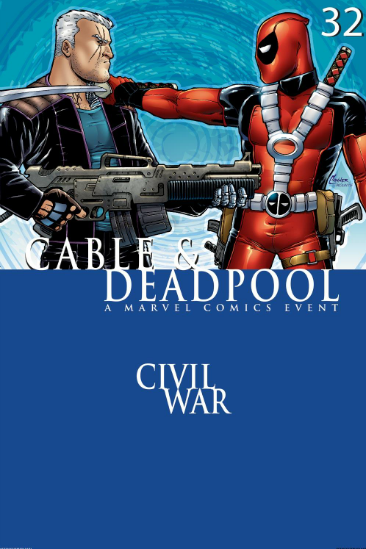 Nicieza’s entire run can be found on Comixology, as well as Marvel Unlimited. In this case I might recommend Marvel Unlimited as the most cost-effective way to read it all.
Nicieza’s entire run can be found on Comixology, as well as Marvel Unlimited. In this case I might recommend Marvel Unlimited as the most cost-effective way to read it all.
The complete run can also be found in book form.

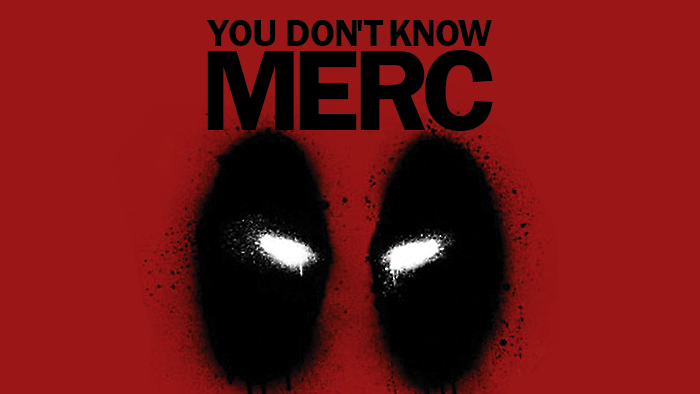
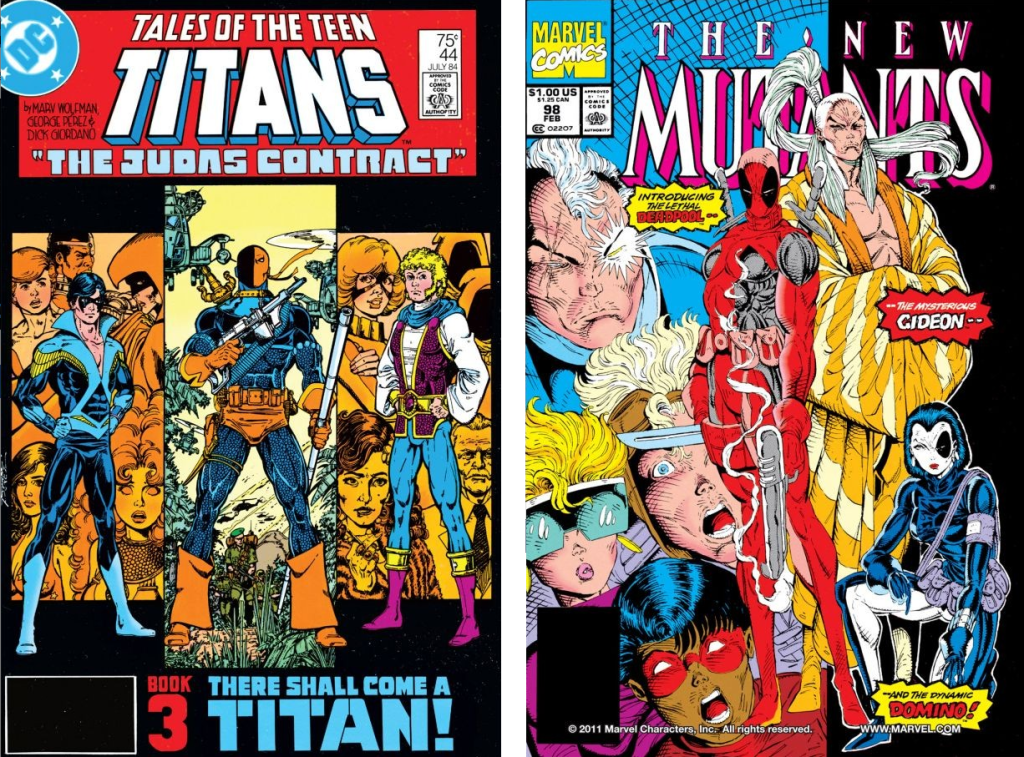
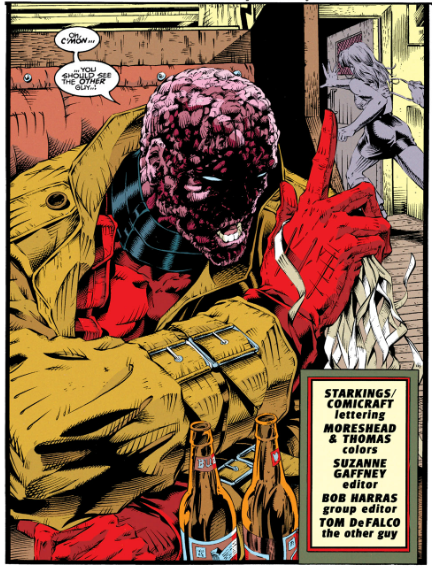
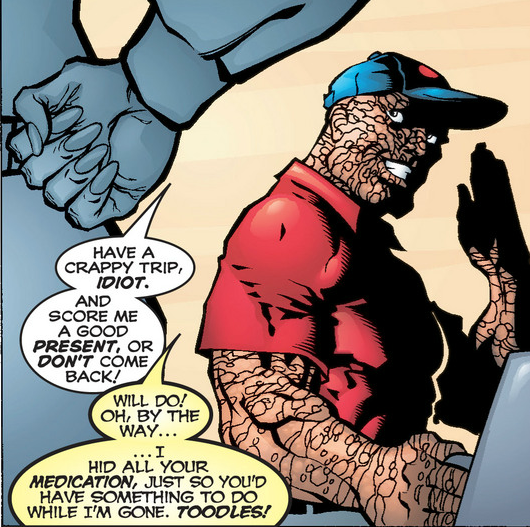
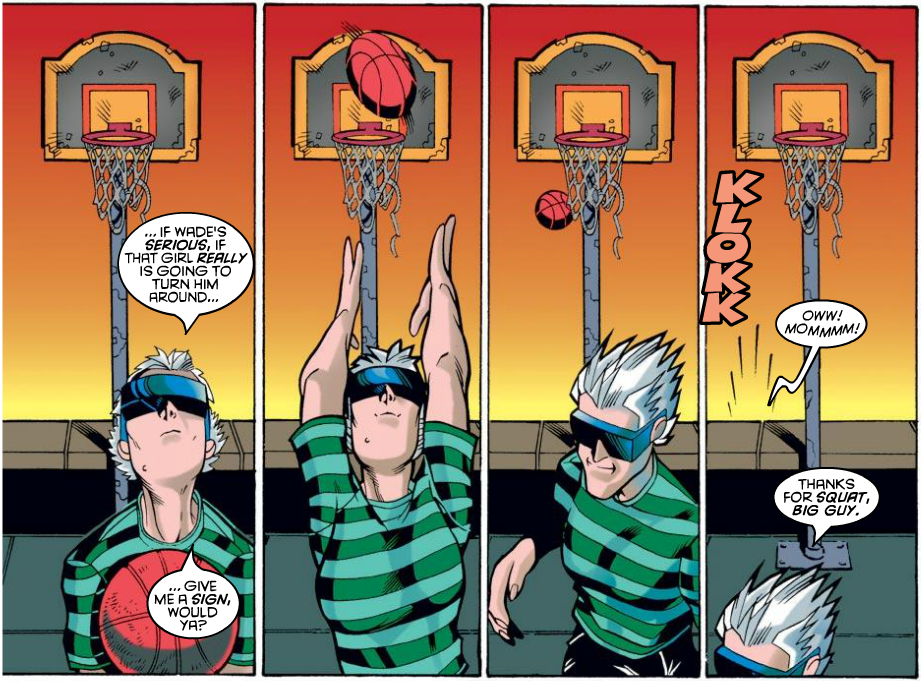
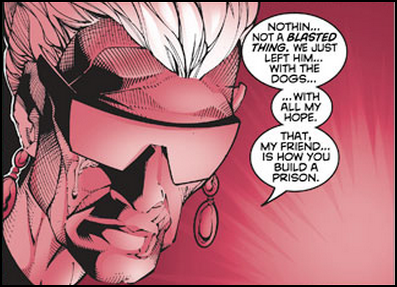
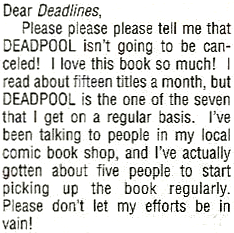

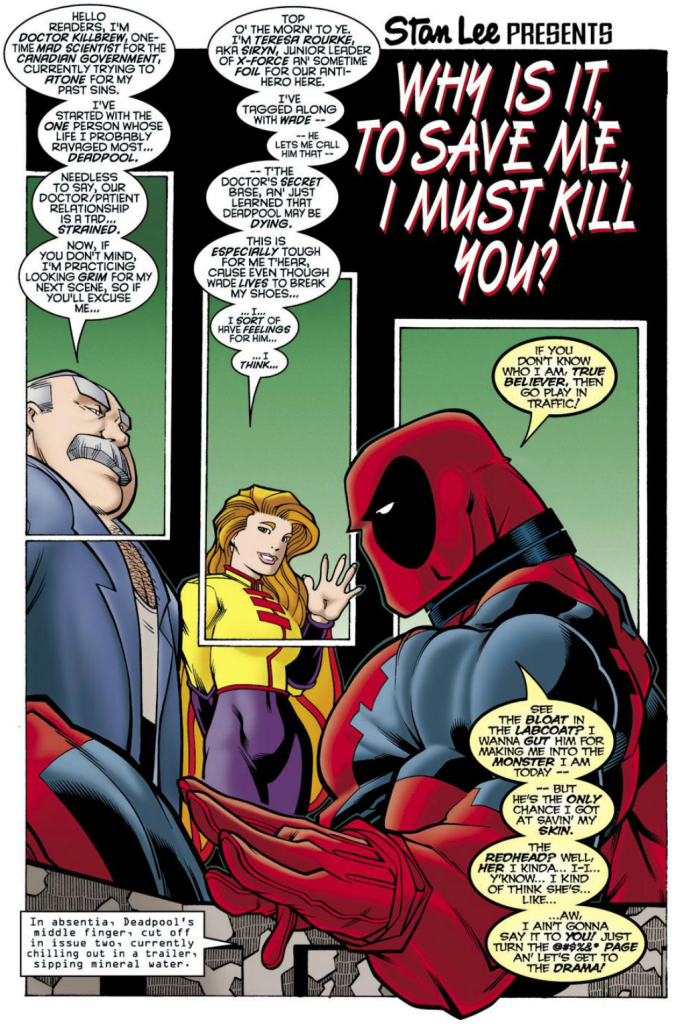
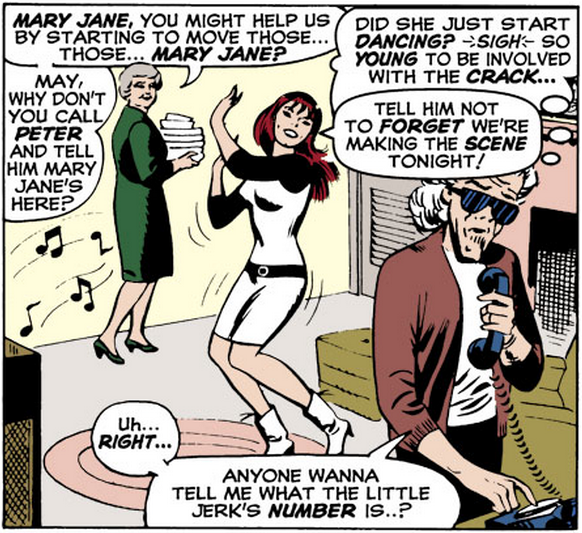


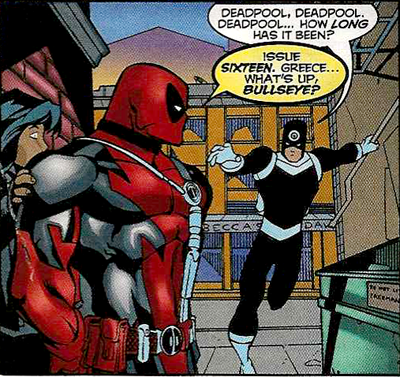

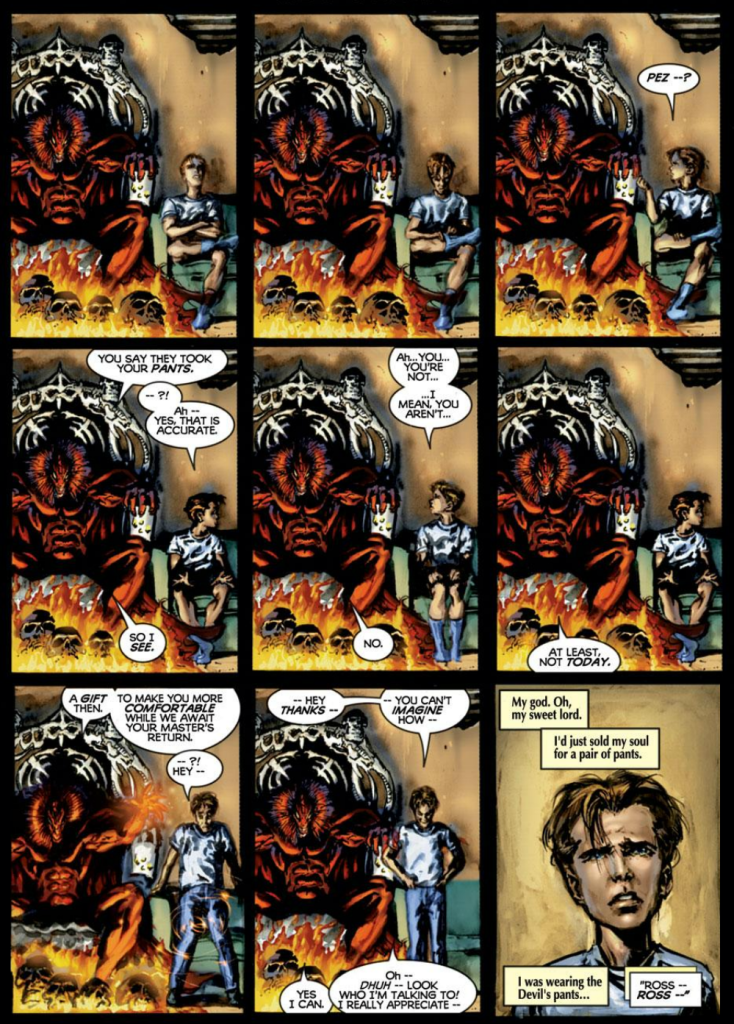
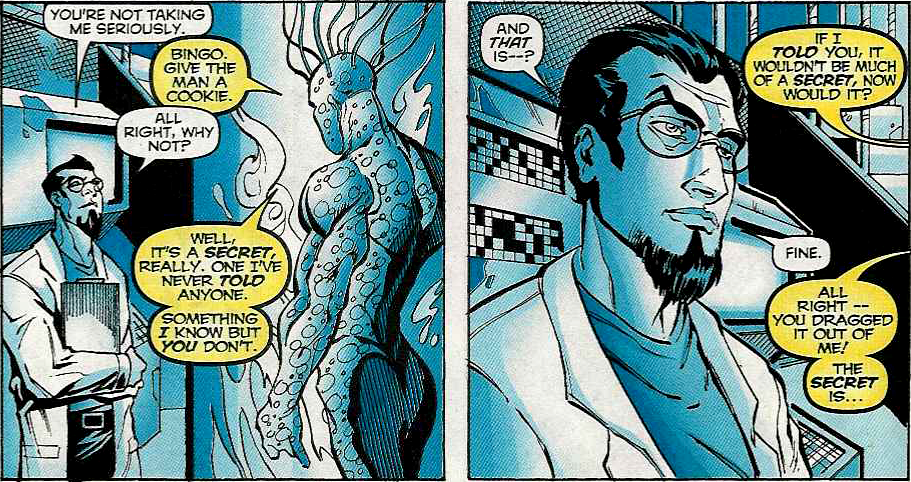

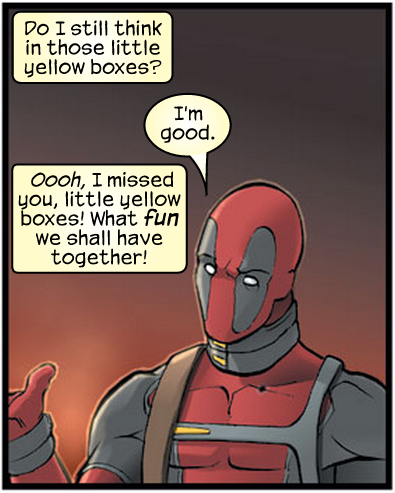

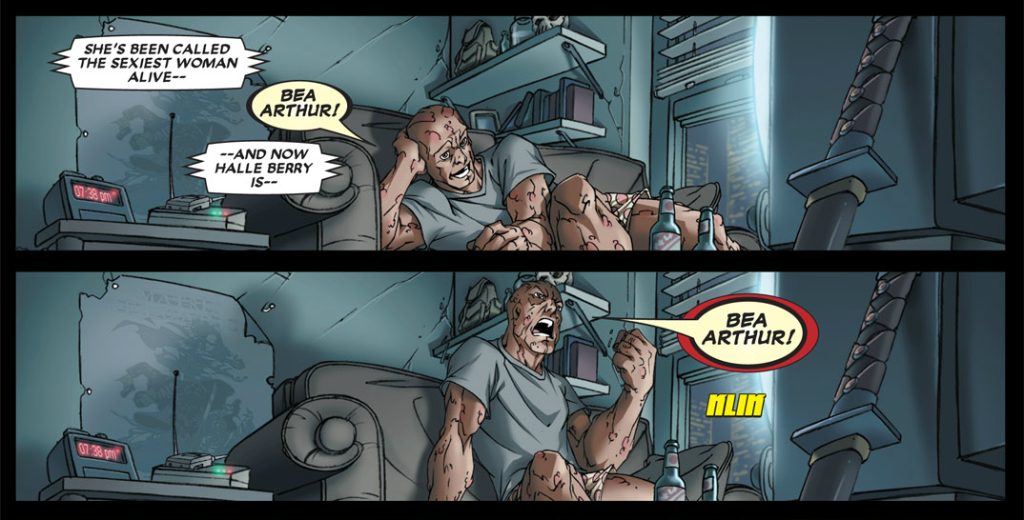
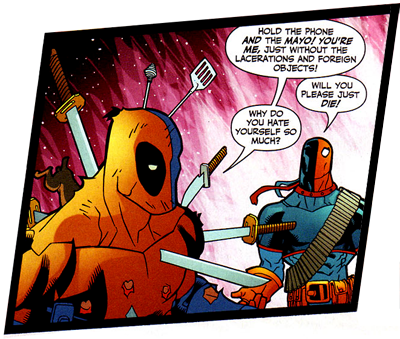
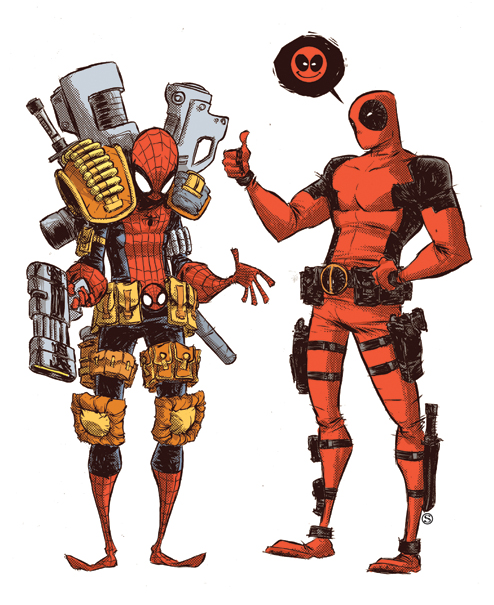
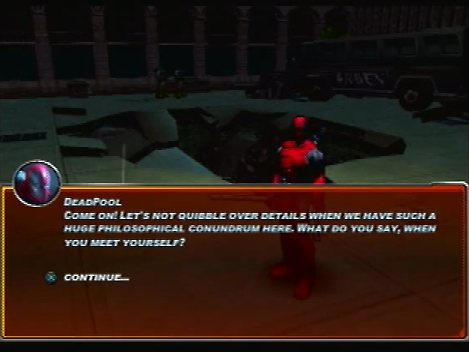
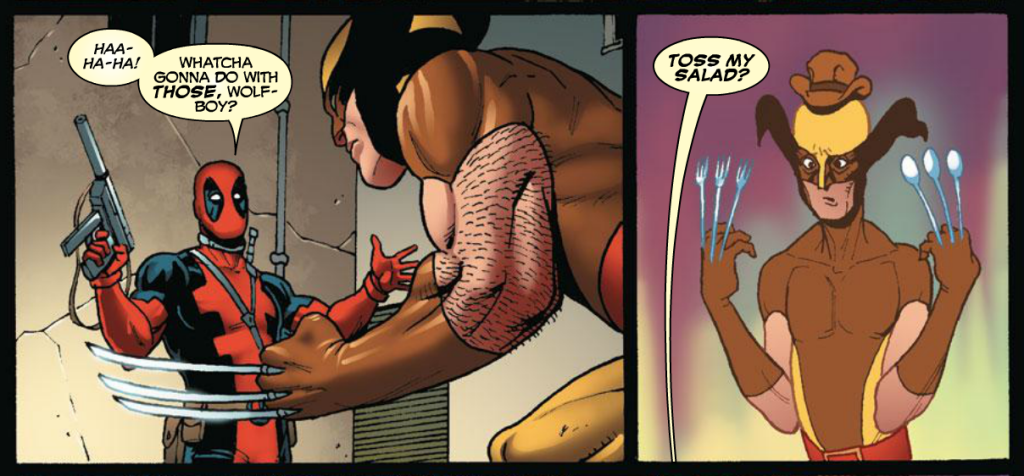

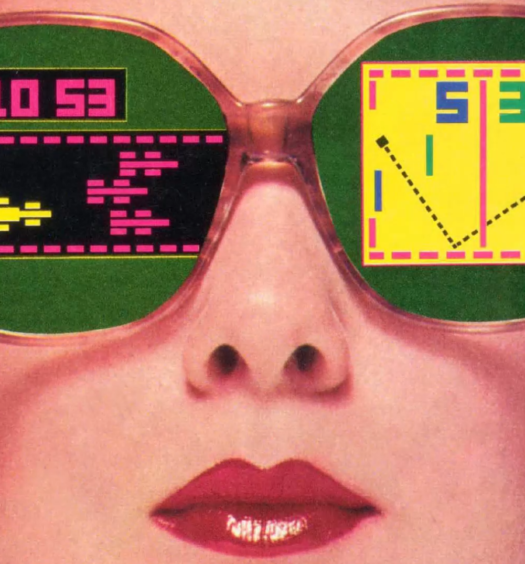








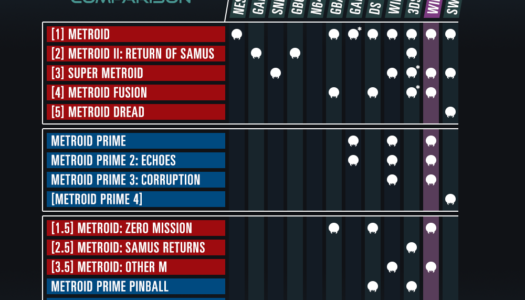
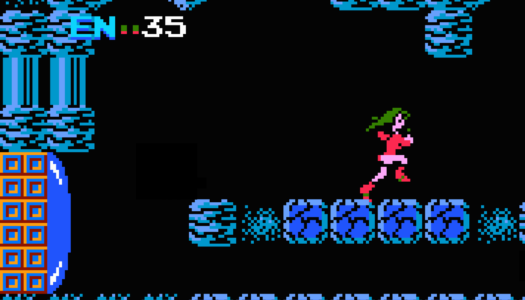
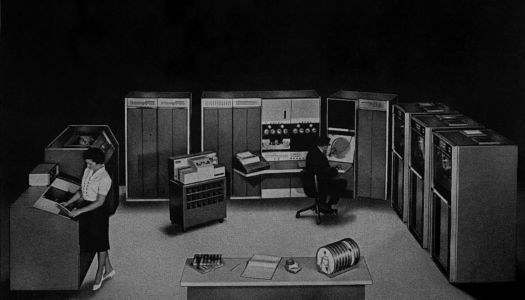
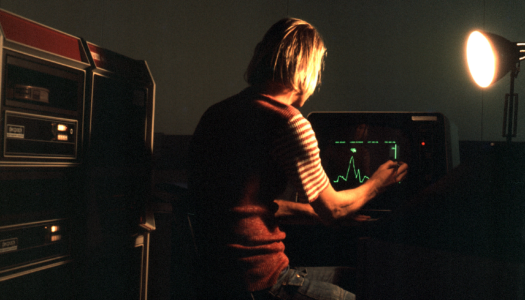
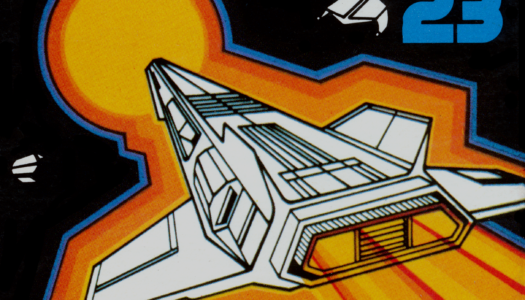

July 8, 2013
As a long-time fan of Deadpool, I honestly didn’t mind the changes Way introduced.
Even before Way’s run, I often wondered the ramifications of having a super healing factor combined with regularly occurring head trauma. On one hand, it could have no effect on the brain’s functions. It’ll just heal and work like it should.
On the other, while it’s in the process of healing, some synapses can momentarily cross in a bad way and leave a short-term or long-term effect. The cell structure of the brain could remain the same, but the misfired/misdirected “electrical pulse” could cause him to gain amnesia, have hallucinations, change his personality, or even gain a few.
So when Way came in, I was shocked at first. But the more I think about it, the more “OK” I am with how things are.